Related Research Articles

Alcamo is the fourth-largest town and commune of the Province of Trapani, Sicily, with a population of 44.925 inhabitants. It is on the borderline with the Metropolitan City of Palermo at a distance of about 50 kilometres from Palermo and Trapani.

Pietro Perugino, an Italian Renaissance painter of the Umbrian school, developed some of the qualities that found classic expression in the High Renaissance. Raphael became his most famous pupil.
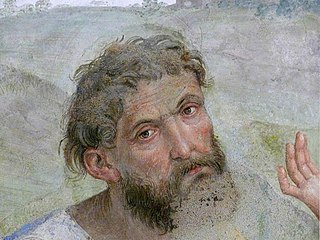
Lo Spagna, "the Spaniard" in Italian, was a painter of the High Renaissance, active in central Italy. His name was Giovanni di Pietro, but he was known as Lo Spagna because he was born in Spain. After Raphael, he was a main pupil and follower of the Umbrian painter Perugino, whose style his paintings developed. He should not be confused with Pietro di Giovanni D'Ambrogio of Siena.
Umbertide is a town and comune (municipality) in the province of Perugia, in the Italian region of Umbria, at the confluence of the Reggia river and the Tiber. It is 30 km (19 mi) north of Perugia and 20 km (12 mi) south of Città di Castello.

Città della Pieve is a comune (municipality) in the Province of Perugia in the Italian region Umbria, located in Valdichiana a few kilometres from the border between Umbria and Tuscany, and about 50 km (31 mi) southwest of Perugia and 11 km (7 mi) southeast of Chiusi in Tuscany.

Fabro is a comune (municipality) in the Province of Terni in the Italian region Umbria, located about 40 km southwest of Perugia and about 60 km northwest of Terni.

Monteleone d'Orvieto is a comune (municipality) in the Province of Terni in the Italian region Umbria, located about 35 km southwest of Perugia and about 60 km northwest of Terni. It is one of I Borghi più belli d'Italia.

Cesare Nebbia (c.1536–c.1614) was an Italian Mannerist painter from Orvieto.

Giannicola di Paolo, also known as Giannicola di Paolo Manni or Smicca, was an Italian painter of the Renaissance period, active mainly in Perugia. He was born in Città della Pieve. His most prominent work is the Madonna delle Grazie in the Duomo of Perugia. He was a pupil of Pietro Perugino, but was also influenced by Raphael. The Museo Gazzola in Piacenza has one of his works.
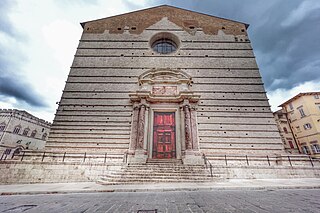
Perugia Cathedral, officially the Metropolitan Cathedral of St. Lawrence, is a Roman Catholic cathedral in Perugia, Umbria, central Italy, dedicated to Saint Lawrence. Formerly the seat of the bishops and archbishops of Perugia, it has been since 1986 the archiepiscopal seat of the Archdiocese of Perugia-Città della Pieve.

Our Lady of Graces or Saint Mary of Graces is a devotion to the Virgin Mary in the Roman Catholic Church. Several churches with this dedication often owe their foundation to thankfulness for graces received from the Virgin Mary, and are particularly numerous in Italy, India, Australia, United States, Portugal, France and the Italian-speaking region of Switzerland. Also it is related to the Marian apparitions in which was revealed the Miraculous Medal, also known as the Medal of Our Lady of Graces.

Santa Maria delle Vigne is a Roman Catholic basilica church in Genoa, Italy. It was built in the 10th century. The main altar was completed in 1730 by Giacomo Antonio Ponsonelli. The church is also the final resting place of the leading early Italian composer Alessandro Stradella, who was murdered in 1682.

Master of Città di Castello, in Italian, Maestro di Città di Castello, was an anonymous painter of Medieval art. Mason Perkins is responsible for his identification and naming in 1908, based on the styling from the Master preserved at the Pinacoteca comunale, Città di Castello, in Umbria.
Alberto Sotio, also Alberto Sozio, was an Italian painter and illuminator of medieval art from Spoleto, active during the second half of the twelfth century.

Sant'Agostino is a Roman Catholic church, originally founded in the 13th-century but refurbished in the following centuries, located on Corso XI Settembre in the historic center of Pesaro, region of Marche, Italy.
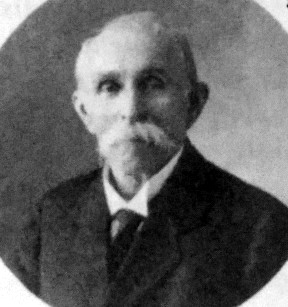
Pietro Maria Rocca was an Italian historian.

Adoration of the Magi is a 1504 fresco by Perugino in the Oratorio di Santa Maria dei Bianchi in Città della Pieve. It shows the Adoration of the Magi, with an idealised view from Città della Pieve towards Lake Trasimene and Val di Chiana in the background. It is often compared to the Adoration of the Magi in the Sala delle Udienze del Collegio del Cambio in Perugia by Perugino and his studio, which includes areas argued by some art historians to have been painted by a young Raphael.

Madonna della Consolazione is an oil on panel painting by Perugino, datable c. 1496–1498. The work, completed in April 1498, was carried out in the Sala delle Udienze of the Collegio del Cambio. Since c. 1820 it is preserved in the National Gallery of Umbria in Perugia.
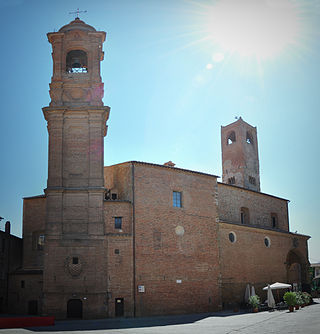
Città della Pieve Cathedral is the principal place of worship of Città della Pieve, Umbria, Italy. It is dedicated to Saints Gervasius and Protasius. Formerly the episcopal seat of the Diocese of Città della Pieve, since 1986 it has been the co-cathedral of the Roman Catholic Archdiocese of Perugia-Città della Pieve.
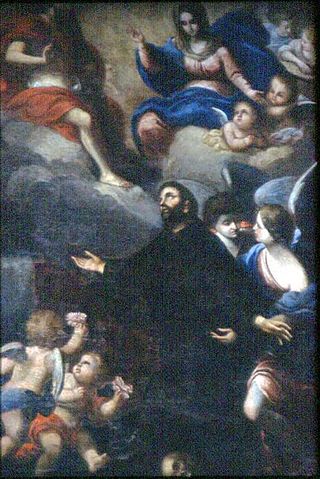
Andrea Carrera or Carreca was an Italian Baroque painter mainly active in Sicily. He was born in Trapani and died in Palermo.
References
- ↑ (in Italian) Mariano Guardabassi, Indice-Guida dei Monumenti dell' Umbria, édition G. Boncompagni & Co, Pérouse, 1872
- ↑ (in Italian) Umberto Gnoli, Pietro Perugino, publication Claudio Argentieri, Spoleto,1923
- ↑ Fernando Corgna, Monteleone d'Orvieto: Storia del paese, delle Chiese e della vita sociale e religiosa, comune di Monteleone d'Orvieto, 2004